An EPDM rubber sheet is an all-weather material that is often used to create industrial outdoor rubber parts and are available as solid EPDM or EPDM sponge. Compared to other elastomers, EPDM, or ethylene propylene diene rubber, is superior in outdoor resistance properties and is highly regarded as an environmentally resistant material used in outdoor industrial applications. In addition to its exceptional outdoor properties, EPDM rubber sheet is also a physically resilient material. It retains a high tensile strength and low compression set, allowing it to stand up well against heavy and repeated impacts. Furthermore, ethylene propylene diene rubber is able to withstand most caustic chemicals, abrasive temperatures, and weathering making an EPDM rubber sheet the ideal material for heavy-duty industrial rubber parts.
What EPDM Stands for?
EPDM stands for the chemical compounds, ethylene, propylene, and diene monomers, which are the primary chemicals used in the production of the material. These chemicals used to production of ethylene propylene diene rubber allows it to be the superior outdoor rubber compared to other elastomers, even synthetic. When these solvents are put through vulcanization, the process in which the chemical compounds are heated to form a solid material, they come together to form the chemical and physical properties of EPDM. For instance, the two monomers, ethylene and propylene, “combine to form a chemically saturated, stable polymer backbone providing excellent heat, oxidation, ozone, and weather aging” (iisrp.com). EPDM was named after ethylene, propylene, and diene monomers because they play a large role in giving an EPDM rubber sheet its unique outdoor resistance property.
What is EPDM Rubber Sheet?
An EPDM rubber sheet is a synthetic rubber material that is used to create outdoor friendly solid and cellular industrial rubber parts. EPDM is best known as an outdoor rubber due to its ability to resist the damaging effects of UV rays, ozone and oxidation as well as harsh weather conditions. As a case in point, “EPDM elastomers have excellent heat, ozone/weathering, and aging resistance. They also exhibit excellent electrical insulation, compression set, and low temperature properties” (polymerdatabase.com). In addition to a high tolerance to outdoor damaging factors, an EPDM rubber sheet also retains a high degree of chemical resistance to most corrosive solvents, but it is not 100% chemically resistant. For example, EPDM rolls “are compatible with polar substances, e.g. fireproof hydraulic fluids, ketone, hot and cold water, and alkalis. It is incompatible with most hydrocarbons, such as oils, kerosene, aromatic, gasoline, as well as halogenic solvents” (Wikipedia.org). Despite its lack of oil resistance, solid EPDM rolls retain great flexibility, pliability, and tensile strength allowing them to stand up well against heavy impacts. On the other hand, EPDM sponge is not as resilient as solid EPDM due to its porous structure and is best used for highly compressive applications rather than impact heavy applications. Overall, even though it is not the most chemically resistant elastomer, an ethylene propylene diene rubber is still a durable material that is ideal for making industrial rubber parts for heavy-duty applications.
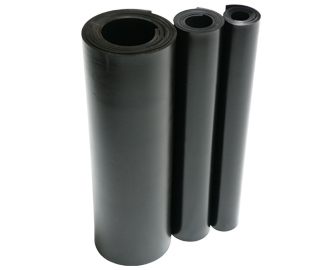
|
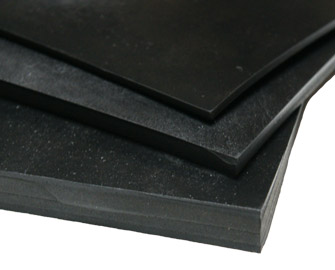
|
What is EPDM Sponge Rubber?
EPDM sponge rubber is the cellular version of its solid form that is characterized by its light and porous structure. This air-filled matrix is created by introducing a foaming agent into the material during its production process. There are two types of EPDM sponge available: open cell and closed cell. Open cell EPDM is differentiated from closed cell EPDM sponge by their larger air pockets and is a highly compressible material due to its porous structure. Its large air pockets allow open cell EPDM sponge to bounce right back to its original form without being permanently indented, even when it has been put under extreme pressure for long periods of time. This makes open cell EPDM sponge material ideal for long-term compression as it maintains a working lifespan that is suitable for constant compression. Closed cell EPDM sponge is a denser material when compared to its open cell counterpart due to its smaller and closely knit air pockets. Like open cell, closed cell EPDM sponge is ideal for high-pressure applications where a high degree of compressibility is required. An advantage closed cell EPDM has over open cell is that it is highly resistant to moisture and the permeation of liquids. This is possible due to its tighter knit pockets of air that create a denser material with an absorption rate of less than 5%. Both open and closed cell EPDM sponge, despite their porous cellular structure, still retain superior resistance to outdoor conditions and can still be used as outdoor rubber materials.
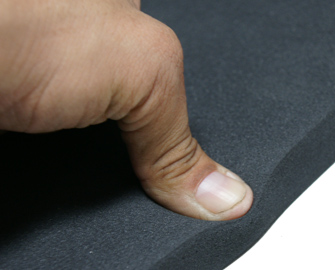
|

|
Is EPDM Toxic?
EPDM is not a toxic material on its own, but the chemicals used in its composition and the fumes emitted when it burns are toxic and can cause serious health ailments. Ethylene propylene diene rubber, whether solid or sponge, are not toxic materials and can be used in residential applications, such as weatherstripping or insulation stripping on refrigeratorss, without worry of dangerous toxins. As a case in point, “this material is not considered to be toxic by the OSHA Hazard Communication Standard (29 CFR 1910. 1200)” (ferris.msdssoftware.com). However, prolonged skin contact may cause irritation as “individuals sensitive to small amounts of curing agents present may develop a rash (dermatitis)” (scribd.com). It is more important to be cautious around the fumes emitted by a burning EPDM rubber sheet and to the chemicals during its production process; however, sensitive individuals may experience still slight reactions when coming into contact with the material itself. For instance, “Lower concentrations of fumes from burning this material may cause respiratory irritation with coughing, difficulty breathing, or shortness of breath. High concentrations may cause severe irritation, pulmonary edema (body fluid in the lungs) with coughing, wheezing, and abnormal lung sounds” (scribded.com). Although an EPDM rubber sheet does not normally general serious health hazards, it can become one when toxic fumes are emitted while the material is burning.
How Long Does EPDM Rubber Last?
EPDM has a long lifespan and can last for years in outdoor conditions despite being exposed to damaging UV rays, ozone, and oxygen. The most notable feature of an EPDM rubber sheet is its resistance to outdoor damaging factors. This property of EPDM allows it to be used and left outdoors for extended periods of times without it being negatively affected by direct sunlight, ozone, oxygen, and moisture. These factors often cause rubber to fade in color, deteriorate, crack, and lose its strength in an application. Additionally, an EPDM rubber sheet retains excellent physical strength and durability with its solid for being available in a 60A durometer rating. Industrial parts made of an EPDM rubber sheet will have outstanding abrasion resistance, high tensile strength, and low compression set allows it to provide ample impact-absorption and compression without becoming damaged or deformed. Its high tensile strength also gives EPDM the ability to work in abrasive temperatures ranging from -40 to 212 degrees Fahrenheit. Furthermore, due to its high degree of chemical resistance, ethylene propylene diene rubber is able to provide a long-lasting installation in heavy-duty industrial applications that may involve corrosive chemicals. Ethylene propylene diene rubber is a resilient synthetic elastomer that was designed to remain a durable outdoor rubber that can last in the outdoors for years to come.
How Much Does a Roll of EPDM Cost?
EPDM rolls vary in cost depending on its length, width, thickness, and form (solid or cellular) with prices ranging from about $24 to $380. Solid EPDM rolls will cost more that cellular EPDM rolls because they are denser which means they are more resilient. An EPDM rubber sheet of 60A durometer is available in gauges of 1/16”, 3/32”, 1/8”, 3/16”, 1/4”, 3/8”, and 1/2” thick and in lengths of 25 or 50 feet depending on the gauge. These solid EPDM rolls range in price from $24.85 to $900.40 and is determined by the length, width, and gauge of the sheet with shorter and thinner sheets being the most cost-efficient. A closed cell EPDM rubber sheet is available in gauges of 1/16”, 1/8”, 1/4”, 3/8”, 1/2", 3/4”, and 1” thick and in set dimensions of 39” wide by 72” long. Because they already have a set dimension, the cost of closed cell EPDM is determined by its gauge thickness and range in price from $23.90 to $378.84. Finally, open cell EPDM rolls are available in gauges of 1/8”, 1/4”, 3/8”, 1/2”, 3/4”, and 1” thick and in set dimensions of 39” wide and 78” inches long. Much like closed cell EPDM, the cost open cell EPDM rolls are determined by their thickness and range in price from $45.20 to $359.24.

|

|
What is EPDM Used for?
EPDM is used for industrial applications involving chemicals and extreme temperatures, but it is best known for its use as an outdoor rubber due to its resistance to UV rays, ozone, and oxygen. Both solid and cellular EPDM are used for different purposed due to their contrasting physical makeups. A common use for both forms of EPDM rubber sheet is for making industrial seals and gaskets. A cellular EPDM rubber sheet is generally used for highly compressive applications because its airy structure allows for better compression than solid EPDM. On the other hand, a solid EPDM rubber sheet is a denser material that holds a high tensile strength which allows it to provide ample shock-absorption properties when used as protective pads, bumpers., or gaskets. In addition, a closed cell EPDM rubber sheet can be used in moisture-related applications due to its tight-knit structure and is often used as a water-resistant electrical insulator. Despite the difference in structure, ethylene propylene diene rubber, both solid and cellular. can be used outdoors without the material deteriorating or losing its strength.
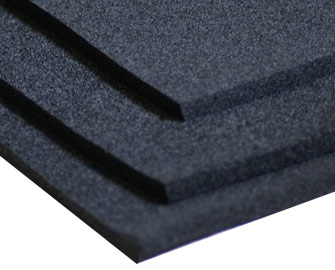
|
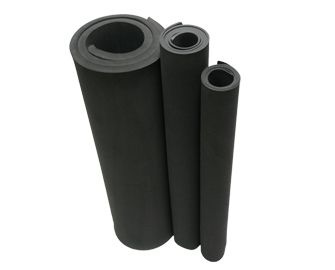
|
How is EPDM Installed?
EPDM is installed by using polyurethane-based glue or pressure-sensitive adhesives due to its resilience, flexibility, and all-weather resistance. It is important to use a polyurethane-based glue as some industrial glues may deteriorate the material over time. Pressure-sensitive adhesives are offered for closed cell EPDM rolls; however, solid EPDM is generally installed using a polyurethane-based glue, but because pressure-sensitive adhesives are not permanent, outdoor use of pressure-sensitive adhesives is not recommended. As an outdoor rubber, EPDM is often used for outdoor industrial applications and, because of this, polyurethane-glue is the best option for installing this elastomer. Another reason polyurethane-based adhesives are ideal for installing ethylene propylene diene rubber is due to its flexibility. For instance, “Reactive urethane adhesives are available as 100% solids or as solvent based systems and as one or two part adhesives. Unlike epoxies, polyurethanes can be formulated to be extremely flexible. They form tough bonds with high peel strength and medium to high shear strength. Since they are very flexible, they are often an excellent choice to bond films, foils, and elastomers” (polymerdatabase.com). Harder and denser glues are not able to flex and bend with an elastomer, such as EPDM. When installing EPDM, you should take into consideration the location and the permanence of the applications when choosing an adhesive.
How do You Glue EPDM Rubber?
You can glue EPDM by using a polyurethane-based adhesive on a clean surface that is free of dust or debris. When installing an EPDM industrial rubber part, such as a gasket, it is important to find the right glue to prevent the deterioration of the material. Polyurethane-based adhesives are ideal for installing EPDM because it offers a tight seal while also being flexible enough to allow for movement and flexing of the ethylene propylene diene rubber. Additionally, because EPDM is an outdoor rubber, it is recommended to use a waterproof glue, like polyurethane-based glues. Polyurethane glue is a fairly weatherproof adhesive that “is waterproof enough to use in all exterior adhesive applications about the waterline” (baileylineroad.com). The use of a polyurethane-based adhesive to install an EPDM part is the most recommended method of installation due to its ability to flex with the elastomer as well as offer all-weather durability.
As the superior outdoor rubber, an EPDM rubber sheet is often used to produce weather resistant industrial rubber parts. Both solid and cellular EPDM rolls are available and they both retain the same outdoor resistance properties as solid EPDM. These properties of EPDM come from the chemical compounds used in its production, ethylene, propylene, and diene monomers, by which the elastomer was named. Ethylene propylene diene rubber is a safe and non-toxic material that is often used in residential applications and is easily installed using a polyurethane-based adhesive. Although EPDM sponge is best used for non-abrasive applications, an EPDM rubber sheet, whether solid or cellular, will be a long-lasting material in outdoor environments as well as in applications involving chemicals and extreme temperatures.